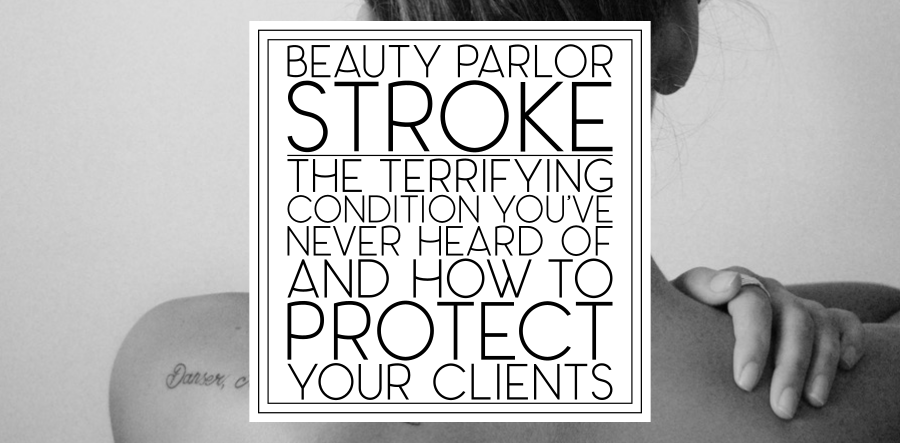Two weeks after having her hair shampooed and blow dried, Elizabeth Smith suffered a stroke. According to her doctor’s report, Smith suffered an artery dissection in her vertebrae, causing a clot to form as the artery repaired itself. The clot broke and traveled to the brain, causing the stroke.
The cause of the artery dissection? The shampoo treatment.
This absolutely horrified me. Initially assuming it was a frivolous lawsuit based on a loose association of symptoms to a salon experience (bolstered by bogus science and sensationalized media), I did some research.
Turns out that it’s not a joke, or frivolous. This is a real thing that really happens–so often in fact that doctors actually have a name for it: Beauty Parlor Stroke.
Defined as “a cerebrovascular accident that occurs in a woman receiving a shampoo in a beauty salon, caused by bilateral compression of the vertebral arteries, which occurs when the head is tilted backwards over the shampoo sink,” Beauty Parlor Stroke isn’t a new problem. The term was coined by Dr. Michael Weintraub in 1993 when he met five women between the ages of 54 and 84 who developed serious neurological symptoms after shampoos at beauty parlors.
FOUR OF THE FIVE SUFFERED STROKES, LEADING TO PERMANENT NEUROLOGICAL DAMAGE.
In June of 2002, The University of Medicine and Dentistry of New Jersey (UMDNJ) performed a study. Researchers found that more than 80% of the 25 subjects used in the study said they suffered neck pain after a simulated shampooing, and 40% experienced dizziness or felt light-headed after extending their necks into the shampoo sink.
THE STUDY SHOWED THAT TILTING THE HEAD INTO THE SALON SINK REDUCES BLOOD FLOW TO THE BRAIN.
In 2006, Marilyn Noonan spent eight days in the hospital on blood thinners after suffering a brain bleed caused by a salon shampoo sink.
A paper from the Department of Neurology, University of Erlangen-Nuremberg warns that Beauty Parlor Stroke, “probably occurs more often than assumed.” Since some of these women can go weeks or months before a stroke is triggered (and many aren’t likely to remember their discomfort during the shampoo by then), that statement is a virtual certainty.
If any of your clients complain about the following symptoms, they may have suffered a vertebral artery injury:
- pain in the neck
- dizziness and imbalance
- nausea
- vomiting
- facial numbness
- tingling
These symptoms can be immediate or can be delayed for hours.
Clients age 50 and over are at greater risk, as are those with atherosclerosis, impaired collateral blood flow, and those with congenital vascular hypoplasia.
Dr. Weintraub suggests that elderly people and professionals who care for them avoid prolonged neck arching, hyperextension, or twisting. He recommends that the neck not be arched backward or twisted more than 15 degrees, and urges salon professionals to consider shampooing elderly clients leaning forward instead. Speed and applied force can also cause the problem, so revisit your shampoo practices to ensure you’re not being overly rough.
Use towels or bolsters as padding on your sinks and make sure your clients aren’t stretching their own necks while you work.
Dr. Thomas Hemmen, a neurologist with the UCSD Stroke Center stresses the importance of not staying in a hyperextended position for a long time (ten or more minutes), so don’t leave your client laying in the bowl to process. Bag their heads and have them sit up straight. (In addition to being risky, this practice is unprofessional as all hell. Stop it.)
Another option is to have your at-risk clients with short or fine hair shampoo themselves at home the morning of the appointment and mist them at your station. Personally, I’m not a fan of that method and only utilized it when clients insisted on it. Because I’ve worked for so long with seniors and clients with impaired/restricted mobility, I prefer to shampoo at-risk clients while they’re sitting up using a shampoo tray.
To be sure, shampoo trays come with a litany of issues. They leak and some can’t be secured to the sink. If you’re not very careful, you’ll end up soaking your client’s back. One of the most frustrating things for me (and my clients) was that shampoo sinks weren’t designed to be friendly for clients with neck problems–and a lot of clients have neck problems that rolled towels can’t alleviate. Why haven’t sink manufacturers addressed this? They hit one out of the park a few years ago by bringing us freestanding sinks, but certainly, more can be done.
Shampoo sink manufacturers: please design a functional sink that doesn’t require hyperextension.
Allow all of our clients to sit comfortably. A long, graduated sink bowl would also benefit long-haired clients, whose hair tends to get tangled in the sink and caught up in the drain.
As a fifteen-year industry veteran, I can say with complete certainty that I have never heard of Beauty Parlor Stroke. This is alarming, and something our cosmetology education companies should definitely be printing in our textbooks. (It’s been five years since I reviewed student training materials, so they may have done so by now.)
Have you come across this in your studies? Has anyone you know ever experienced this? What do you think we should do to protect our clients? Let me know in the comments!









7 Responses
The terrible design of shampoo chairs is exactly why I cradle the clients neck by splitting my middle and ring finger (think Spock) and placing my hand under their neck while doing any hard scrubbing. It removes all pressure from their neck, and can be used to massage said neck as well. I try to cradle their head as much as possible throughout the shampoo process. “This is especially important with color, as I’m sure we all know how much pressure needs to be applied to thoroughly remove it.”
My arm is long enough so while I’m cradling the clients head I can rest my elbow on the back of the sink. Also… I use my weak arm to cradle (right arm… im left handed), so I stand on the clients left side.
Hopefully a few pick up this great trick and give great shampoos. I had the reputation in every salon I’ve been in as the best shampoo in the house. All you have to do is take your time, put some thought into your routine, and you will be too!
Too often is it a forgotten, rushed, sloppy affair. And they notice the difference, always.
In beauty school we served a clientele consisting largely of elderly women and we were (casually) cautioned that it could cause issues for our clients, but reading this emphasizes for me how serious the problem really is. It terrifies me to think that I, as a professional, could be doing something to cause my clients’ harm as serious as a stroke. I’m curious to know if the European-style adjustable sinks help to alleviate some of the strain? In school we had the old-style basins and clients complained all of the time, the salon I work in now however has adjustable sinks. Either way, it’s worth paying close attention to. Pain may be the price of beauty, but that cost is just too high.
I was not only shocked about this because I was never told of it, but who assumes liability for this woman’s injuries at this point? She’s suing the salon as if they should have known, but I highly doubt they did know. I can guarantee the bowl manufacturer did, though.
I am a chiropractic physician. I’ve enjoyed reading Ms. Tina’s articles so I thought I would make a contribution here.
The same problem described in this article can happen when a person turns their head to back up a car. It can happen with neck manipulation, often by untrained individuals and by those using self manipulation. Lastly, it can also happen spontaneously without any provoking event. Since chiropractic physicians are the professionals most associated with neck manipulation they often get blamed for these types of events, even if the injured individual never received treatment from one. This has been well documented.
These events are mostly secondary to injury to the vertebral arteries. (Involvement of the carotid arteries in these events is exceedingly rare because of the difference in their location relative to the vertebral arteries.) When an artery get damaged, either by repeated micro trauma or by acute severe trauma, the body works to repair the injured area by blood clot formation and arterial wall repair. The result is a thrombus. Like any injury, the area damaged can be painful, as well as refer pain to related areas like the neck. The thrombus may impair blood flow to the brain. If the thrombus becomes dislodged it is then called an embolus. That embolus can become lodged in smaller blood vessels downstream and cause occlusion of blood flow. This type of occlusion is what we call an occlusion stroke and can cause neurological problems like dizziness, nausea, distorted vision, numbness, difficulty walking or talking, and other signs and symptoms of stroke. The sum of these problems is often what we call a cerebrovascular accident, or CVA. That is the type of event described by this article.
The challenge is that predicting who is at risk for these types of vertebral injuries and CV accidents is extremely difficult, even by a trained physician. The most common population is middle aged women on birth control pills, but because this problem is so rare and occurs over such a wide range of ages and sexes there really is no definite demographic. The best thing to do as a service professional is be aware of the signs and symptoms of vertebral artery dissection (injury to the wall of the artery) and of stroke. The reason for this is that people can have an injury or be in the process of having a stroke before they even sit in your chair! New patients have had strokes sitting in clinic waiting rooms of chiropractic physicians. Can you imagine who might have gotten blamed if they had been incidentally treated with a neck adjustment the week before? The same can happen to you as a hair stylist. You may be completely without fault but still get blamed because the hair shampoo simply occurred before the stroke. NCMIC is an insurance company for chiropractic physicians and has assembled a summary article on this topic to help physicians decrease their risk exposure. I think the same principles of risk awareness can be applied to beauty professionals. Here’s the link.
http://www.chiro.org/LINKS/FULL/Current_Concepts.pdf
I believe that the key take home lesson for us as service professionals to learn is that the health of the customer is primarily their responsibility, not ours. It is their actions on a regular and daily basis that primarily determines the health of their vertebral arteries and remaining cardiovascular system, not the actions that we engage with them briefly and occasionally. Although many people would like to shift the blame of their poor health and bad treatment outcomes onto their physicians, or hair stylists in this case, the responsibility for, and the ownership of, their health is truly theirs. Not their physican’s nor hair stylist’s. It is wise for us as professionals to first be aware of the health of our clients, including warning signs of impending problems and problems in process, to protect both ourselves and our clients from injury by not engaging in a service where it appears inappropriate for that individual. It is also wise for us to try to adapt our services when it appears that a particular service could potentially be harmful to the average customer. Sean Daniel’s description of cradling necks to help protect them from injury is probably good practice, but may best be applied to those with apparently healthy necks.
Although following a traumatic experience in which we are being blamed it can be instinctive for some to try to rectify the situation by assuming fault or questioning their fault, it’s best to take a long view and consider all the factors that went into that event, including lifestyle decisions made by the injured individual long before the event in question occurred. This isn’t to say that responsibility shouldn’t be taken for likely harmful actions. Rather, that a more measured approach be used to assess and take responsibility in any particular exchange and relationship. Particularly one involving a highly emotionally charged subject like cerebrovascular accidents.
I hope that this input is helpful. This is a subject that our profession has had to deal with.
Dr. Sundgren
PS – One additional and confounding factor is that many of the signs and symptoms of vertebral artery dissection and stroke are similar to signs and symptoms found in vertebral subluxations. Ie, Those with neck vertebrae problems may also experience problems secondary to those musculoskeletal problems such as cervicogenic dizziness, vertigo, and nausea. These secondary problems may look like stroke symptoms, but they are in this case from a different cause. So it gets a little difficult determining cause of the symptoms relative to that person’s body and their experiences in life. Taking a longer view by looking further backward in history and digging deeper in examination and treatment helps partially resolve these challenges. For the hair stylist (or salon sink maker) accused of causing the CVA that means understanding these many factors that go into creating these types of symptoms and encouraging their attorneys to take a broader view of the circumstances surrounding the apparent CVA.
I hope I wasn’t too verbose here! I’m not sure how else to explain this problem and its potential solutions.
PPS – I never liked a hair shampoo personally unless a thick towel was used or the stylist cradled my neck as Sean Daniel described. Just uncomfortable otherwise!
Thank you so much for your comment Dr. Sundgren! It’s spectacular!
Wow, Tina! Dr. Sundgren’s response is so very informative!
It’s fantastic, isn’t it? Luckily, we’re seeing more shampoo chairs that are highly adjustable–ones with longer and wider neck basins. The chairs move up, down, forward, and back, and the bowls tilt to accommodate a wide range of clients to ensure there’s a comfortable fit for everyone. Unfortunately, most of these shampoo bowls are still cost prohibitive, but I expect that’ll change in the future.